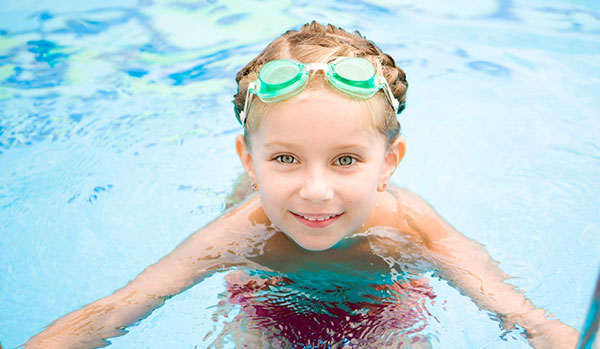
For babies and children, we have developed a method designed to involve, motivate and determine them to overcome the fear of the unknown. Each session is 50 minute long, however, this duration is adapted to the age and individual physical and motor abilities, and can be shorter if the effort capacity is exceeded. An aquatic education session includes 4 stages, customized by duration and content for each child and each stage of development.
1.Adjustment through play
The adjustment starts right from the entrance to the complex, all the spaces and facilities are friendly and adapted to the children’s needs. At the entrance, a cheerful robot, with a big heart and a white cap, performs the epidemiological triage which involves: automatic temperature scanning with facial recognition of each person to be admitted inside and thermal transfer protection of footwear by disposable foil. If we have excess time, we can play, using one of the 4 play areas: lego, consoles, tablets or train. Then we access the locker room area. The complex has a number of 8 locker rooms adapted to each age (4 for children, 2 for instructors, 1 for kinesiotherapists and 1 for children with motor disabilities). Here we prepare for access to the pools, we acclimatize to the temperature inside that is higher than outside, we take a short shower using age-appropriate facilities, after which we enter the magical area of the aquatic education pools. Children with motor disabilities will enjoy increased attention: they have their own locker room, stepping chair for stairs and hydraulic chair for access to the pool. Each baby is picked up by an instructor and has his/her own aisle. The adjustment to the pool starts on its edge, by playing with various floating objects, and when the baby has overcome the fear of the unknown (the first sessions) or is ready for physical effort, he/she will familiarize with water. Again, floating objects and mattresses are used and for a few minutes, until the child adapts to the new environment and is ready to acquire new information.
2. Aquatic activities adapted to age, physical and motor abilities
Depending on the stage of development and the momentary availability of the child, the method of acquiring information, skills and automatisms related to moving in the water is followed. Babies will move in the water entirely with the help of the instructor, using support that does not block his/her movements. In the process of gradual learning and increase of resistance to effort, we use non-toxic teaching materials specific to the activity and age, in pursuit of various objectives as follows:

5- 18 months(Splash Infants Program)
- Accommodation with the aquatic environment
- Stimulation of the apnea reflex at the time of immersion
- Stimulating the movement of the lower and upper limbs
- Stimulation of the vertical position in the aquatic environment, which prepares the bipedal position on ground and voluntary walking
- Stimulation of grasping (grasping reflex)
- Stimulation of muscle tone
18-36 months(Splash Starters Program)
- Development of volitional qualities
- Development of the ability to concentrate
- Adaptation and movement in the aquatic environment
- Learn the mechanism of aquatic respiration
- Stimulation of swimming specific movement of the lower and upper limbs
- Increase the capacity of effort by developing motor qualities such as strength, speed and endurance, as well as their forms of manifestation
- Development of coordinative capacity (spatial-temporal orientation, mobility-suppleness, rhythm and pace)
36 months + (Splash Movers and Splash Flyers Programs)
- There is a qualitative leap from aquatic education to swimming procedures
- The swimming procedures are introduced one by one
- Correct the wrong movements and fundamental mistakes that can lead to improper learning of swimming procedures
- Learning and perfecting the foot-breathing coordination
- The mechanism of aquatic respiration is learned in coordination with the specific movements of the lower and upper limbs
- Increase in effort capacity
3. Recovery after effort
The aquatic education or swimming session ends with a stage of the body’s recovery after the effort. Its role is to adjust the functional parameters (respiratory rate, respectively heart rate) to rest values. This is also achieved through exercises, with a gradual decrease in intensity, avoiding the fatigue.

4. Final motivation
It is achieved through the game, the instructor introducing some interactive themes, using platforms, perforated mattresses, floating mattresses, etc. A few minutes of good mood at the end of the hour, which will give us motivation for the next sessions.
Acquisitions and benefits:
- Contributes to the development of musculoskeletal system.
- Improves the little one’s cognitive functions. Specific movements in the pelvis by which the little one has to coordinate several parts of his/her body virtually “push” the brain to create more complex neural patterns.
- Contributes to the normal development of premature babies and children with neuromotor risk at birth.
- Improves social skills. It develops the ability to interact with people and to adapt very quickly to a new environment.
- Contributes to solving postural deficiencies.
- It is a form of exercise that uses all the muscles of the body. For this reason, the little ones familiar with the swimming pool have a strong and harmonious physical structure. Moreover, such activity significantly contributes to cardiac and pulmonary development.
- Increases emotional intelligence
- Improves motor functions. Children have a better developed balance function and coordinate their movements much more easily.
- It contributes to the preservation of primary reflexes and their transformation into automatisms.
- Significantly improves sleep.
- Increases appetite.
- Develops the ability to respond to unknown or extreme situations.
- Controls child obesity. When it has no pathological causes, child obesity has.
- Increases immunity
 Account access
Account access  Registration
Registration